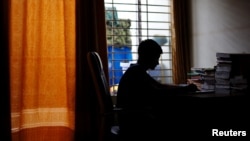Hena Khan is a ninth-grade student in Dhaka, Bangladesh. She struggled to keep attention on her studies last week as temperatures rose above 43 degrees Celsius in Bangladesh’s capital.
"There is no real education in schools in this punishing heat," she said. "Teachers can't teach, students can't concentrate. Rather, our lives are at risk."
Khan is one of more than 40 million students who have been shut out of classrooms in recent weeks. Heatwaves have forced school closures in parts of Asia and North Africa. As the climate warms due to the burning of fossil fuels, heatwaves are lasting longer and reaching higher temperatures.
Government officials and public health experts across the world are increasingly struggling with whether to keep students learning in hot classrooms.
Either decision has impacts. About 17 percent of the world's school-aged children are already out of school, says the United Nations. But the proportion is much larger in developing countries.
Test scores in the developing world also behind developed countries.
Heat could worsen inequalities by widening learning gaps between wealthy countries and poor nations in the tropics, experts told Reuters. It could even worsen inequalities between rich and poor areas in wealthy countries. Sending children to hot schools can also make them sick.
Earlier this spring, heat-related school closures in South Sudan affected over 2 million students. Temperatures rose to 45 degrees Celsius there in late March. Thousands of schools in the Philippines and in India closed schools in late April, impacting more than 10 million students.
Last week, Cambodia ordered all public schools to cut two hours off the school day to avoid the peak heat at midday.
Bangladesh has debated whether to close schools for about 33 million students. Temperatures there are rising to dangerous levels.
Many Bangladeshi schools "don't have fans, the ventilation is not good, and they… (do) not provide good insulation," said Shumon Sengupta. He is Bangladesh country director for the nonprofit organization Save the Children.
Even if students continue attending classes during heatwaves, their education is likely to suffer. High temperatures slow down the brain's functions, lowering students’ ability to remember and process information.
A 2020 study found that American high schoolers performed worse on standardized tests if they were exposed to higher temperatures in the year leading up to the exam.
The research was published in the American Economic Journal. It found that a .55 Celsius degree warmer school year reduced that year's learning by 1 percent. Schools with air conditioning did not feel those same effects, said study co-writer Josh Goodman. He is an economist at Boston University.
Goodman and his research partners found similar learning results tied to heat when they looked at standardized test data in other countries. "When (students in) these places experience a year with more heat, they appear to have learned less," he said.
Other research suggests high heat in the tropics can also impact a child's education even before birth.
Children in Southeast Asia exposed to higher-than-average temperatures in utero and early in life received fewer years of schooling later in life. That information comes from a 2019 study in the Proceedings of the National Academy of Sciences.
Goodman said as the world warms, already hot countries that become extremely hot countries will suffer more than cooler countries. "Climate change will widen the learning gaps between hot and cool countries," Goodman said.
Some developed countries are trying to find solutions to the issue.
In March, the U.S. Agency for International Development (USAID) announced it would build 30 heat-resilient schools in Jordan by 2026, a USAID spokesperson said. Heat-resilient buildings can remain comparatively cool in very hot weather.
USAID said it would spend $8.17 million on the schools. The schools would have special cooling systems and air conditioning.
The number of days that schools are closed for extreme heat has been increasing in the United States. Few countries record such data.
In Bangladesh last year, schools were closed for 6 to 7 days, said Save the Children's Sengupta. "But this year, they are saying it might be closed for 3 to 4 weeks," he said.
May is often the hottest month in South Asia.
I’m Dan Novak.
Dan Novak adapted this story for VOA Learning English based on reporting from Reuters.
____________________________________________
Words in This Story
punish — v. to make suffer for a crime or for bad behavior
concentrate — v. to think about something
impact — v. the act or force of one thing hitting another
proportion — n. an amount that is a part of a whole
gap — n. a space between two people or things
ventilate — v. to allow fresh air to enter and move through
insulation — n. a material or substance that is used to stop heat, electricity, or sound from going into or out of something
expose — v. to leave without covering or protection
in-utero — n. before birth
resilient — adj. able to become strong, healthy, or successful again after something bad happens










Forum